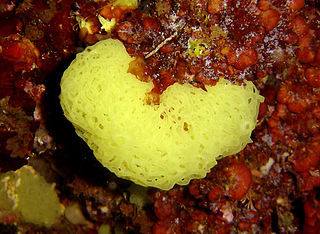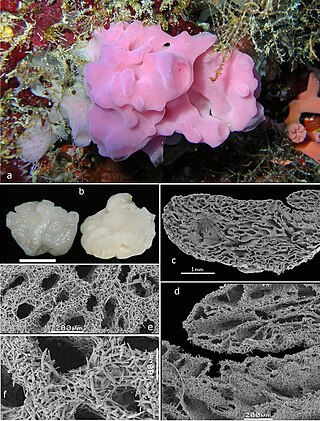
Cladorhiza is a genus of carnivorous sponges, comprising around 40 species found in oceans around the world. Cladorhiza is the type genus of the family Cladorhizidae.

Clathrina is a genus of calcareous sponge in the family Clathrinidae. Several species formerly in Clathrina were transferred to the newly erected genera Arturia, Ernstia, Borojevia, and Brattegardia in 2013. The name is derived from the Latin word "clathratus" meaning "latticed".

Grantia is a genus of calcareous sponges belonging to the family Grantiidae. Species of the genus Grantia contain spicules and spongin fibers.
Ernsta cordata is a species of sea sponge in the family Clathrinidae found in South Africa. The name means "heart-shaped" in Latin.

Sycon is a genus of calcareous sponges belonging to the family Sycettidae. These sponges are small, growing up to 7.5 cm with a length from 2.5 to 7.5 cm, and are tube-shaped and often white to cream in colour. They are known to aquarium hobbyists as "Pineapple" or "Q-Tip" sponges, and are frequent "hitchhikers" accidentally brought in.

Auletta is a genus of sponges in the family Bubaridae.

Arturia is a genus of calcareous sponge in the family Clathrinidae which contains 14 species. It is named after Arthur Dendy, a prominent researcher of calcareous sponges. It was renamed Arturia in 2017 because the name Arthuria was already assigned to a genus of molluscs.

Neoernsta is a genus of calcareous sponges in the family Dendyidae. The genus was erected in 2013 to contain five species previously assigned to Clathrina. The genus name honors German naturalist Ernst Haeckel for his contributions towards sponge taxonomy and phylogeny.
Amphoriscus is a genus of calcareous sponges in the family Amphoriscidae.
Ascandra is a genus of calcareous sponges of the family Dendyidae and are found in oceans around the world.
Trichogypsiidae is a family of sponges in the class Calcarea.
Kuarrhaphis is a genus of calcareous sponges in the family Trichogypsiidae. It consists of one species, Kuarrhaphis cretacea.
Leucyssa is a genus of calcareous sponges in the family Trichogypsiidae. It consists of one species, Leucyssa spongilla.
Ascaltis is a genus of sponges in the family Leucascidae, first described in 1872 by Ernst Haeckel.
Vosmaeropsis complanatispinifera is a species of calcareous sponge in the family Heteropiidae, and was first described in 2015 by Cavalcanti, Bastos & Lanna. It is found off the Brazilian coast.

Leucascus is a genus of sponges belonging to the family Leucascidae.

Leucetta primigenia is a species of calcareous sponge in the family Leucettidae, and was first described in 1872 by Ernst Haeckel.
Pericharax is a genus of sponges in the family Leucettidae, which was first described in 1883 by Poléjaeff.










